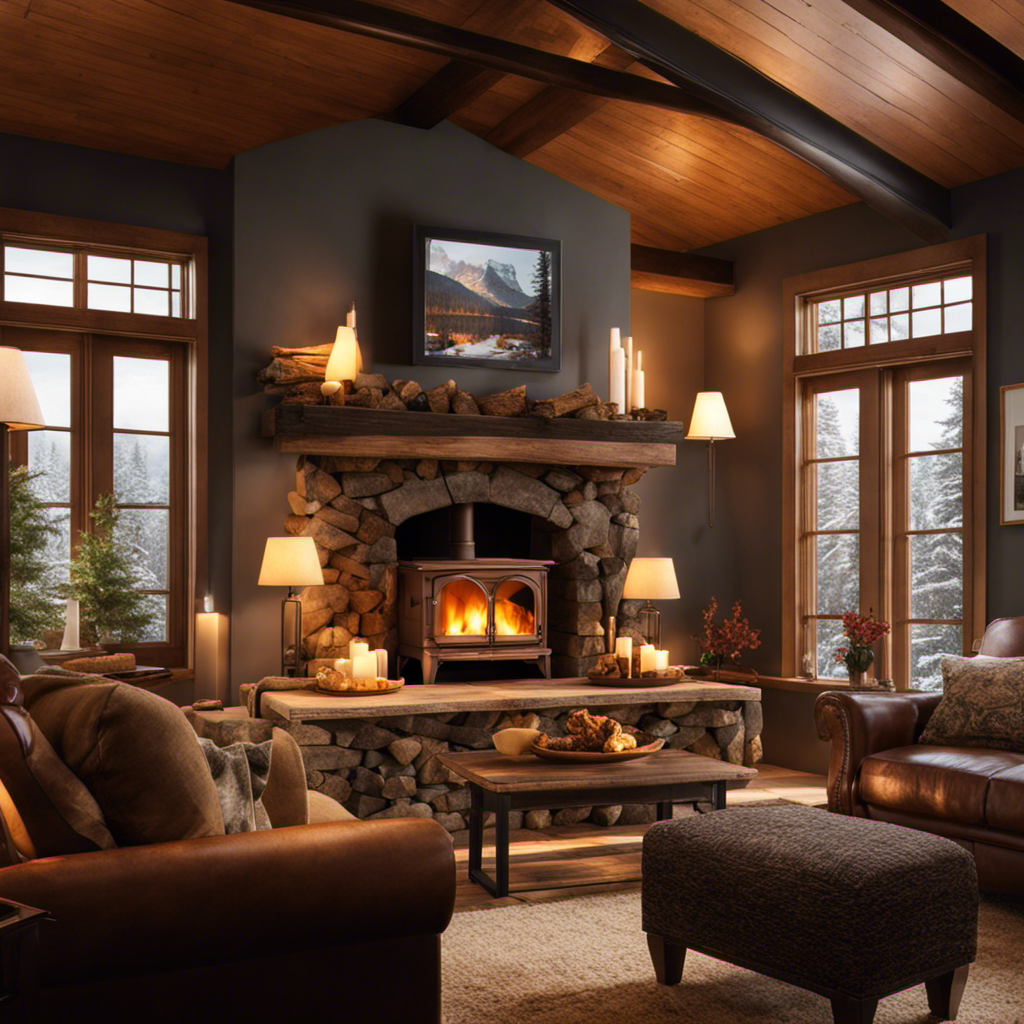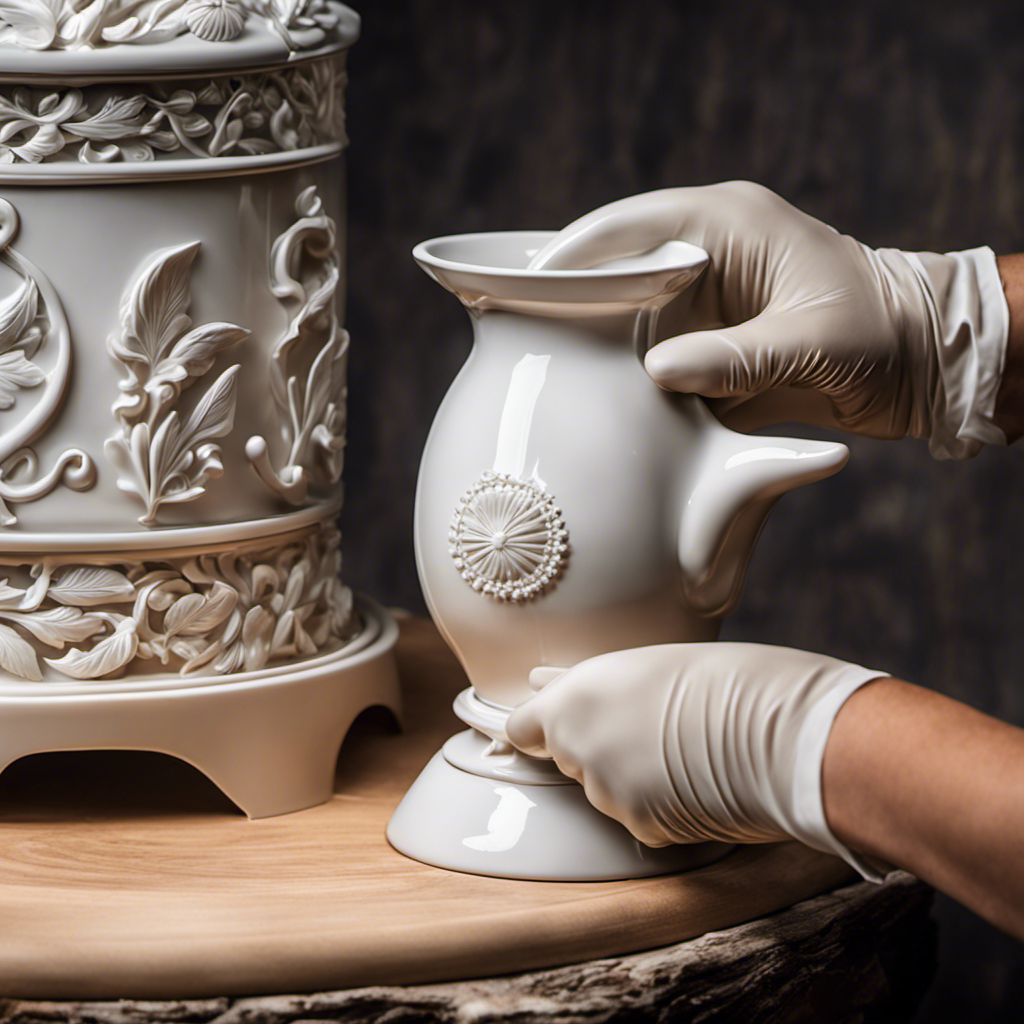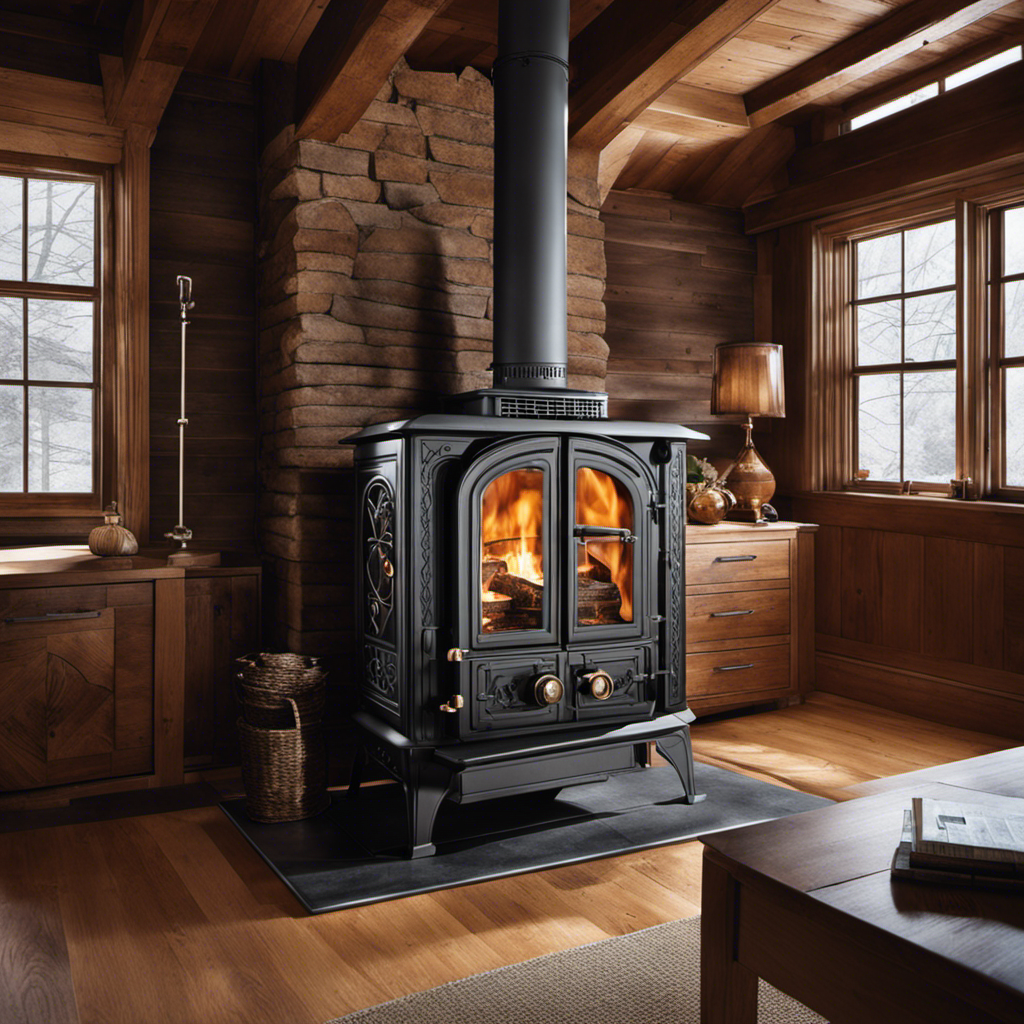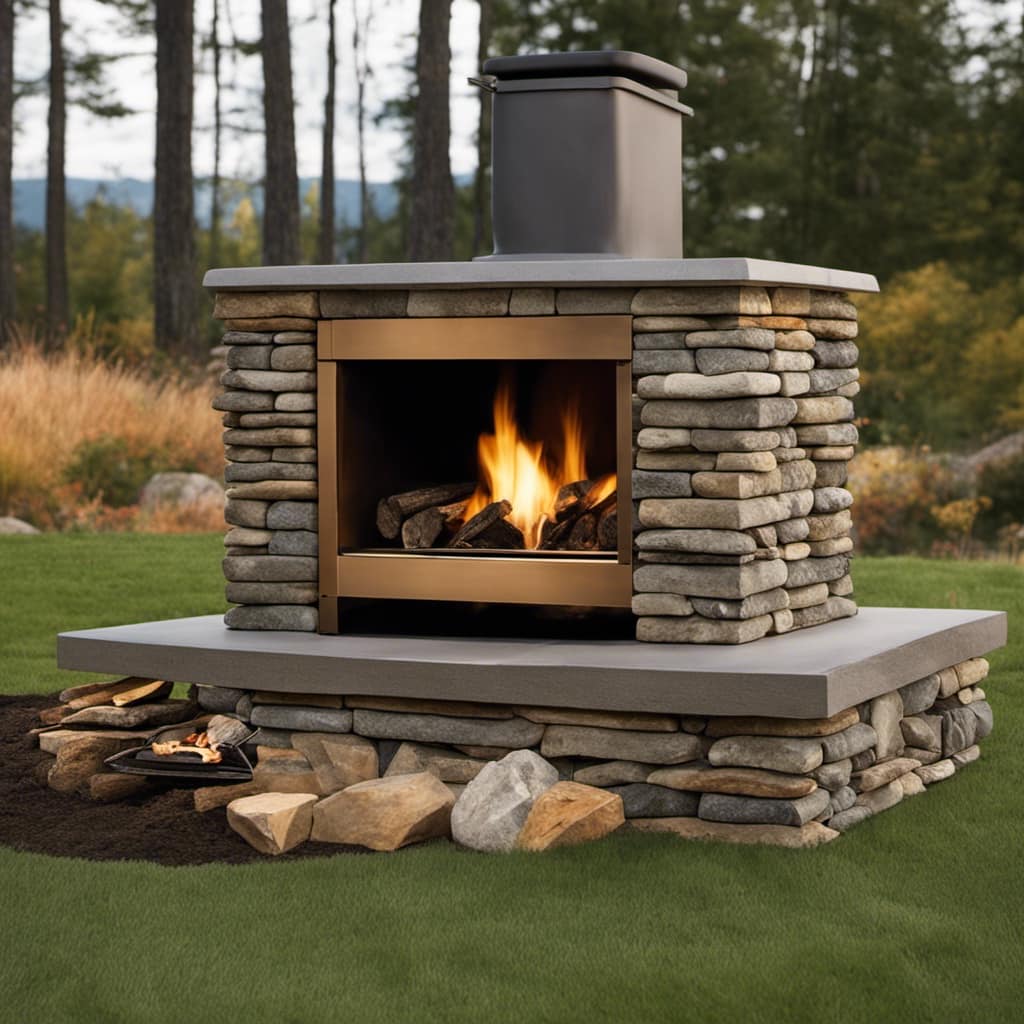You want to comprehend the way a wood stove heats up a home, huh? Well, allow me to simplify it for you.
When you light up that fire, the wood starts to burn, releasing heat energy in the process. This heat is then transferred to the surrounding air, which circulates throughout the room, gradually raising the temperature and making it cozy and warm.
It’s like having your very own mini fireplace, bringing comfort and warmth to your humble abode.
Key Takeaways
- Wood combustion releases energy in the form of heat.
- Heat is transferred through convection, radiation, and conduction.
- Proper insulation and furniture arrangement enhance heat distribution.
- Controlling airflow and using a blower help maximize heat output and distribution.
The Principle of Heat Generation in a Wood Stove
As I examine the principle of heat generation in a wood stove, I realize that the combustion of wood releases energy in the form of heat. This heat is then transferred from the burning wood to the surrounding air and objects in the room through a process called convection.
The combustion process starts when the wood is ignited, either by a match or a spark. Once ignited, the wood undergoes a chemical reaction known as combustion, where it combines with oxygen from the air to produce carbon dioxide, water vapor, and heat.
The heat is then transferred to the surrounding air through convection, as the hot air rises and circulates around the room, warming everything in its path. This process continues until all the wood has been burnt, providing a steady and reliable source of heat for the room.
Understanding the Heating Process of a Wood Stove
I can gain a better understanding of the heating process of a wood stove by observing how the heat is transferred through convection and radiation.
The combustion process in a wood stove produces heat, which is then transferred to the surrounding environment through various mechanisms. Here’s a breakdown of the heat transfer mechanisms involved:
-
Convection: As the hot gases rise from the burning wood, they create a natural convection current. This current carries heat upwards, warming the air in the room. The warm air then circulates, distributing the heat throughout the space.
-
Radiation: The hot surfaces of the wood stove emit infrared radiation, which travels in straight lines and heats objects and surfaces it comes into contact with. This radiant heat is particularly effective at warming people and objects in the room.
-
Conduction: The heated surfaces of the wood stove come into direct contact with nearby objects, transferring heat through conduction. This direct transfer of thermal energy causes objects in close proximity to the stove to become warmer.
Factors Affecting the Efficiency of a Wood Stove’s Heat Distribution
To maximize the efficiency of a wood stove’s heat distribution, it’s important to consider factors such as the arrangement of furniture and the use of a heat-powered fan.
Insulation techniques play a crucial role in improving the efficiency of a wood stove. By properly insulating the walls, ceiling, and floors of the room where the stove is located, heat loss can be minimized, allowing for more effective warming of the space.
Additionally, the type of wood used in the stove can greatly impact heat distribution. Hardwoods, such as oak or maple, have a higher energy content and burn longer, providing a steady and consistent heat output. Softwoods, on the other hand, burn faster and produce less heat. Therefore, proper wood selection is essential for optimal heat distribution and efficient operation of the wood stove.
Exploring the Role of Airflow in Heating a House With a Wood Stove
By controlling the airflow and using a blower, I can effectively distribute the heat from the wood stove throughout the house. Here’s how it works:
-
Importance of Insulation: Proper insulation is crucial for maximizing the efficiency of a wood stove. It prevents heat loss and keeps the warm air inside, ensuring that the house remains comfortably warm.
-
Impact of Stove Placement: The location of the wood stove plays a significant role in its heating effectiveness. Placing the stove in a central location allows for better heat distribution. It also helps to position the stove on an insulated surface, such as a hearth, to prevent heat from escaping into the floor.
-
Controlling Airflow: By adjusting the stove’s damper, I can regulate the amount of air flowing into the firebox, controlling the burn rate and heat output. Using a blower to circulate the warm air further enhances the distribution, pushing it into other rooms and ensuring a more even temperature throughout the house.
Maximizing the Heat Output of a Wood Stove for Effective Home Heating
Adjusting the damper and using a blower are essential for maximizing the heat output of a wood stove and ensuring effective home heating.
The damper controls the airflow, which directly impacts the combustion process. By adjusting the damper, you can regulate the amount of air entering the stove, thereby controlling the intensity of the fire. This allows for better utilization of the fuel and ultimately maximizes fuel efficiency.
Additionally, using a blower helps distribute the heat more evenly throughout the house. It works by forcing the warm air generated by the stove to circulate, reaching all corners of the room.
To further enhance the efficiency of your wood stove, proper insulation is crucial. Insulating your home effectively prevents heat from escaping, ensuring that the warmth generated by the stove stays inside, resulting in a more comfortable living space and reduced energy consumption.
Frequently Asked Questions
What Are the Different Types of Wood Stoves Available in the Market?
There are several different types of wood stoves available in the market. When comparing their efficiency and cost, it’s important to consider installation and maintenance requirements.
How Does the Size of the Wood Stove Affect Its Heating Capacity?
The size of a wood stove greatly affects its heating capacity. A larger stove can generate more heat and warm a larger area efficiently. It’s important to choose the right size stove for optimal heating performance.
Can a Wood Stove Be Used as the Primary Source of Heat in a House?
Yes, a wood stove can be used as the primary source of heat in a house. Wood stove efficiency varies depending on factors like insulation and stove design. Cost comparison shows wood stoves can be a cost-effective heating option.
What Are the Safety Precautions That Need to Be Taken When Using a Wood Stove?
Safety precautions and maintenance tips must be followed when using a wood stove. Proper installation, regular cleaning, and keeping flammable materials away are crucial. Monitoring the stove, using a fireproof hearth, and having a carbon monoxide detector are also important for safety.
Are There Any Environmental Considerations When Using a Wood Stove for Heating?
When using a wood stove for heating, it’s important to consider the environmental impact. An efficiency analysis can help determine the stove’s carbon footprint. For example, a properly installed and maintained stove can reduce reliance on fossil fuels and decrease greenhouse gas emissions.
Conclusion
In conclusion, the wood stove is a powerful ally in the battle against the cold. With its principle of heat generation and efficient heating process, it radiates warmth throughout the house.
Factors such as airflow and proper maintenance play a crucial role in maximizing its heat distribution. By harnessing the full potential of a wood stove, you can transform your home into a cozy sanctuary.
Where the flickering flames dance and the comforting heat embraces you like a warm hug on a winter’s night.
Growing up surrounded by the vast beauty of nature, Sierra was always drawn to the call of the wild. While others sought the comfort of the familiar, she ventured out, embracing the unpredictable and finding stories in the heartbeat of nature.
At the epicenter of every remarkable venture lies a dynamic team—a fusion of diverse talents, visions, and passions. The essence of Best Small Wood Stoves is crafted and refined by such a trio: Sierra, Logan, and Terra. Their collective expertise has transformed the platform into a leading authority on small wood stoves, radiating warmth and knowledge in equal measure.











